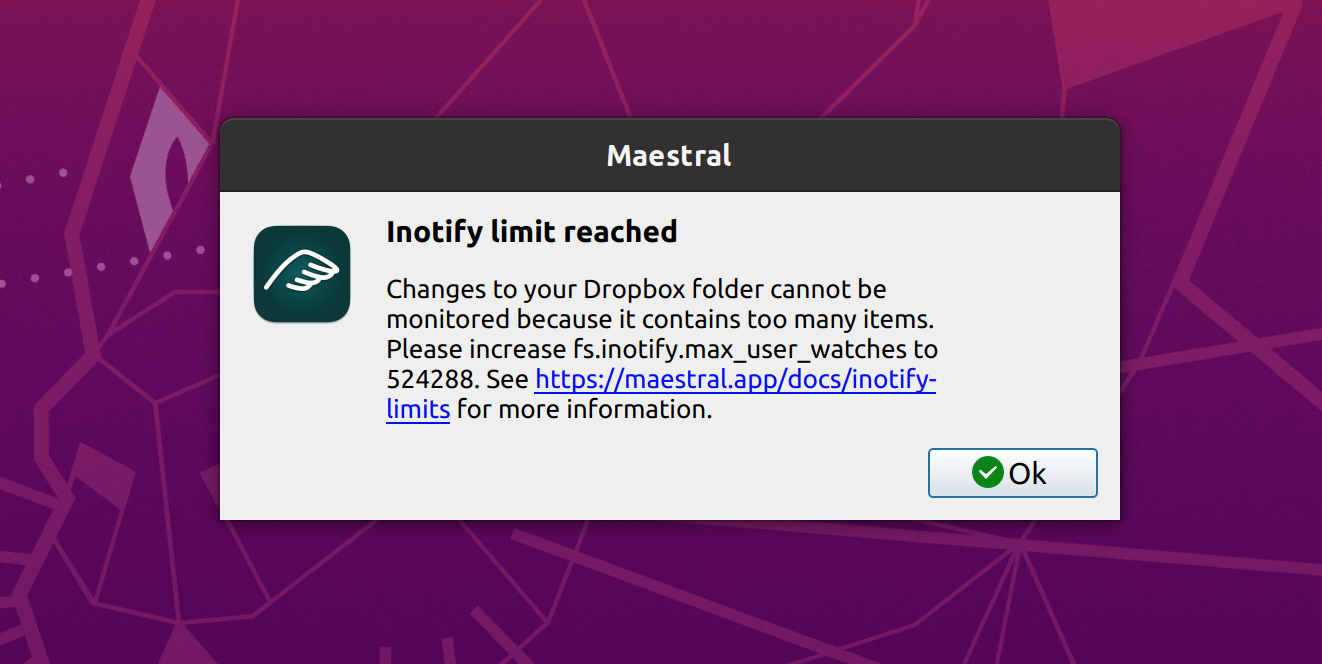Inotify limits
On Linux, the sync daemon uses the inotify facility of the kernel to be notified of changes to local files and folders. Inotify provides fine-grained information about the creation, modification and deletion of files but only allows you to watch a limited number of folders because each “watch” requires a small amount memory. The limit holds for all applications that subscribe to be notified of file system events, including IDEs and other sync clients.
There are in fact two limits which are important to us:
-
max_user_watches: This is the maximum number of folders which can be watched for file changes. Subfolders are counted separately so that a local Dropbox folder with five subfolders would need six inotify watches in total.
Since the introduction of the inotify in 2005,
max_user_watchesis set to 8192 by default. Available memory has increased significantly since then and Linux kernels since version 5.11 will automatically adjustmax_user_watchesup to 1048576 depending on the available RAM. Linux 5.11 was released in February 2021 and at the time of writing, most distributions still use an older kernel version. -
max_user_instances: This is the maximum number of inotify instances allowed for each user. Most processes will only create a single instance but some may create multiple. This value defaults to 128 for most distributions.
You can check the current limits on your system with sysctl:
$ sysctl fs.inotify
fs.inotify.max_queued_events = 16384
fs.inotify.max_user_instances = 128
fs.inotify.max_user_watches = 524288
If you hit either of those limits, the sync daemon will log an error message and the GUI will show a notification with brief instructions on how to increase the limit. For example:

Increase the inotify limits
To increase the inotify limits permanently (across reboots), you can set the values in
the configuration file /etc/sysctl.conf. For instance, adding the following lines to
set the maximum number of watches to 524,288 and the maximum number of instances to
1024:
fs.inotify.max_user_watches=524288
fs.inotify.max_user_instances=1024
Then reload the configuration with sudo sysctl -d for the changes to take effect. You
will also need pause and resume syncing for any new limits to apply to Maestral.
You can also set the limits temporarily, until the next reboot, with sysctl:
$ sudo sysctl fs.inotify.max_user_watches=524288
Be sure to choose limits that are higher than the total number watches created by all processes.
How many inotify watches and instances do I need?
If you are curious to see how many inotify watches are currently running, you can filter
the ouput of lsof for inotify watches:
$ lsof | grep inotify | wc -l
Likewise, if you’d like to know which programs have created an inotify instance, you can run:
for foo in /proc/*/fd/*; do readlink -f $foo; done | grep inotify | sort | uniq -c | sort -nr
This will get all inotify instances for each process, count the number of instances for each process and display the output hierarchically with processes that use the most instances coming first. An example output could look like this:
4 /proc/9370/fd/anon_inode:inotify
2 /proc/2942/fd/anon_inode:inotify
1 /proc/2570/fd/anon_inode:inotify
1 /proc/2524/fd/anon_inode:inotify
The above output tells us that the process with PID 9370 is consuming 4 inotify instances.